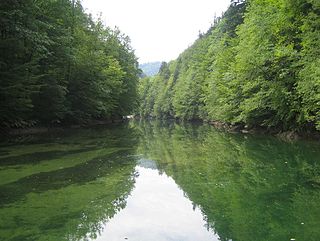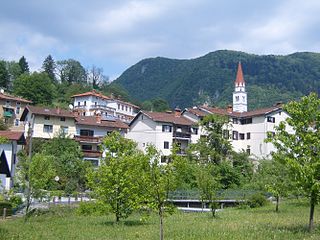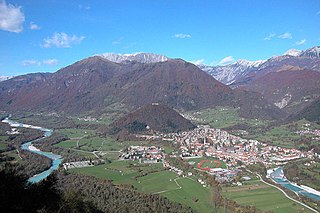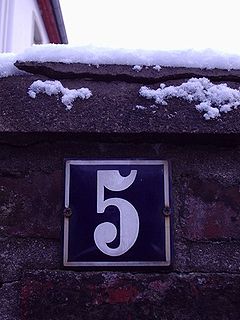
Idrija is a town in western Slovenia. It is the seat of the Municipality of Idrija. It is located in the traditional region of the Slovenian Littoral and is in the Gorizia Statistical Region. It is notable for its mercury mine with stores and infrastructure, as well as miners' living quarters, and a miners' theatre. Together with the Spanish mine at Almadén, it has been a UNESCO World Heritage Site since 2012. In 2011, Idrija was given the Alpine Town of the Year award.

Kanal, frequently referred to as Kanal ob Soči, is a settlement mostly on the left bank of the Soča River in the Slovene Littoral, the traditional region in southwestern Slovenia. It is an important crossing point over the Soča. At its eastern border, on the left bank of the Soča, runs the Bohinj Railway, the railway track linking the Central Europe and the Mediterranean.
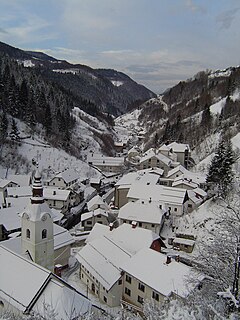
Podbrdo is a settlement in the Municipality of Tolmin in the Littoral region of Slovenia. It lies in narrow valley of the Bača River, next to the Bohinj Railway line at the end of the longest railway tunnel in Slovenia and next to the road from Bohinjska Bistrica and Železniki across Petrovo Brdo towards Most na Soči.

The Vintgar Gorge or Bled Gorge is a 1.6-kilometer (0.99 mi) gorge in northwestern Slovenia in the municipalities of Gorje and Bled, four kilometers northwest of Bled. Carved by the Radovna River, it is the continuation of the Radovna Valley. The sheer canyon walls are 50 to 100 meters high, with a total slope measuring about 250 m (820 ft). The stream has created many erosive features such as pools and rapids, and terminates in the picturesque 13 m (43 ft) Šum Falls, the largest river waterfall in Slovenia. As the first mountain gorge in the area to be made accessible to tourists, the word vintgar has been generalized in Slovene to refer to other scenic, protected gorges, e.g. the Iška Gorge, the Bistrica Gorge on Pohorje and the Ribnica Gorge in Bohinj.

Bukovski Vrh is a small settlement above Bukovo in the Littoral region of Slovenia. It lies on a plateau high above the Bača Valley in the Municipality of Tolmin.

Gorenji Log is a small settlement on the left bank of the Soča River southwest of Most na Soči in the Municipality of Tolmin in the Littoral region of Slovenia. The Bohinj Railway line runs through the settlement.

Gorski Vrh is a small dispersed settlement in the hills north of the Idrijca River in the Municipality of Tolmin in the Littoral region of Slovenia. It is accessible from the village of Slap ob Idrijci via Šentviška Gora.

Grahovo ob Bači is a village on the Bača River in the Municipality of Tolmin in the Littoral region of Slovenia.

Hudajužna is a village in the valley of the Bača River in the Municipality of Tolmin in the Littoral region of Slovenia. The Bohinj Railway line runs through the settlement.

Klavže is a settlement in the Bača Valley in the Municipality of Tolmin in the Littoral region of Slovenia.

Pečine is a village in the mountains above the right bank of the Idrijca River in the municipality of Tolmin in the Littoral region of Slovenia. It includes the hamlets of Črni Vrh, Kabiunk, Kal, Maraževec, Podkal, Travnik, and Stari Rut.

Šentviška Gora is the main settlement in the hills between the valleys of the Bača and Idrijca rivers, known as the St. Vitus Plateau or Šentviška Gora Plateau, in the Municipality of Tolmin in the Littoral region of Slovenia.

Nadlesk is a village south of Stari Trg in the Municipality of Loška Dolina in the Inner Carniola region of Slovenia. The settlement includes the hamlets of Hrib, Sredi Vasi, and Kot.

Ciril Kosmač was a Slovenian novelist and screenwriter.

Rovišče is a settlement in the Municipality of Zagorje ob Savi in central Slovenia. The area is part of the traditional region of Upper Carniola. It is now included with the rest of the municipality in the Central Sava Statistical Region. It includes the hamlet of Zasavska Gora, also known as Sveta Gora.

Podbrdo railway station serves the settlement of Podbrdo, in the municipality of Tolmin, Slovenia.
The Tolmin dialect is a Slovene dialect in the Rovte dialect group. It is spoken in the watersheds of the Bača and lower Idrijca rivers, as well as the reaches of the Soča River in that area, bounded on the west by a line west of Tolmin and Most na Soči. Other settlements in the dialect area include Grahovo ob Bači.
Sveta Lucija may refer to several places in Slovenia:

